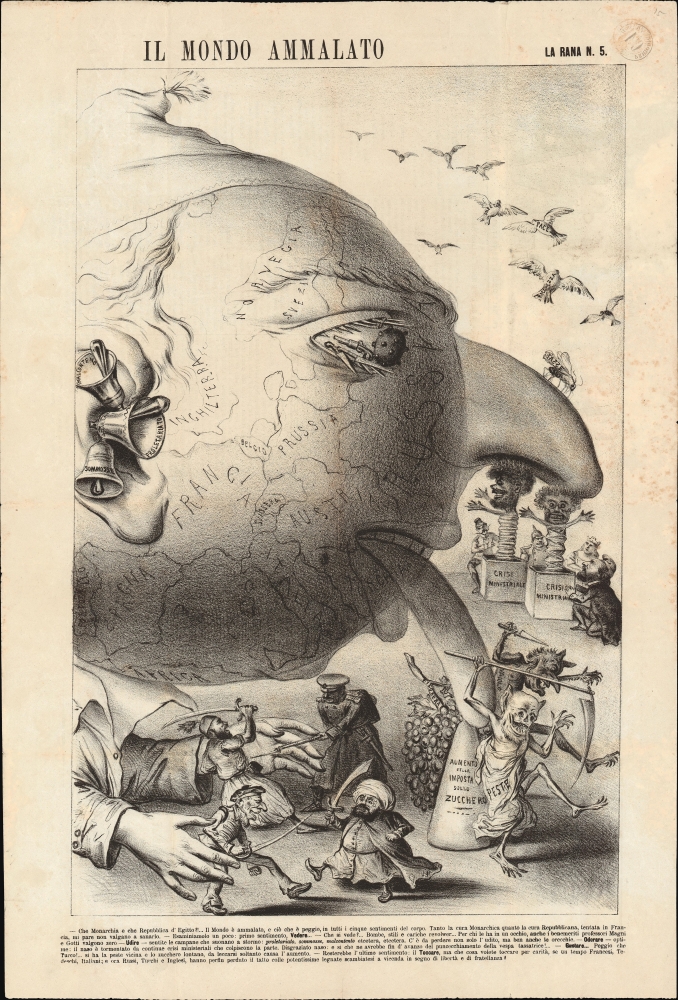1878 'La Rana' Allegorical Map of the World as a Sick Man
MondoAmmalato-rana-1878
Title
1878 (dated) 24 x 16 in (60.96 x 40.64 cm)
Description
Monarchy or Republic of Egypt!? … The World is sick, and what is worse, in all five senses. Both the Monarchic cure and the Republican cure, were attempted in France, but it seems they did not heal him. - Let us examine it: first sense, Sight. What do you see? …Bombs, Knives, and Revolvers. … For those who have them in one eye, even the worthy professors Magni and Gotti are worth nothing. Hearing, the bells are ringing like a storm: Proletariat, Riots, Discontent, etcetera, etcetera. Not only hearing, but also ears are to be lost. Smell - [optime] the nose is tormented by continuous cabinet changes. Wretched nose: left over from the pricking of the tax mosquito! Taste … Worse than Turkish! …You have the plague nearby and the sugar far away, licking only makes it worse. The last sense remains, Touch, but who do you touch for care, once France, Germany, Italy; and now Russia, Turkey, and England have abandoned he once powerful treaties exchanged in a sign of freedom and brotherhood! (Geographicus translation)Understanding the Historical Context
Most of this content is vague and hard understand without an intimate awareness of the political situation in Europe early in 1878. A lot was going on. In Egypt, Khedive Ismail was being pressured to accept a constitutional ministry limiting his former autocratic power. France continued to suffer social discontent under both the Second Empire and the French Third Republic. Russia and Turkey were at the time involved in the Russo-Turkish War, which affected all of southeastern Europe. At the same time, most European countries increased their sugar tax, most particularly Austria-Hungary, leading to economic instability. The text references Francesco Magni (1828–1887) and Vincenzo Gotti (1836 - 1822), well known Bologna based medical doctors and professors, positioning them as allegories for scientific reason. Meanwhile, Russia, Turkey, and England were bypassing old treaties and alliances in an effort to expand their power bases.
Census and Publication History
The broadside is the centerfold for the 1 sheet Bolognese monarchist periodical, La Rana. All issues of La Rana consist of a single broadsheet, printed on both sides, which folded in half made a 4-page newspaper, including a 2-page centerfold. La Rana was popular, but often censured due to its constant ribbing of powerful political figures, consequently, examples today are rare. The present example of Il Mondo Ammalato, labeled La Rana N. 5 is the only know surviving example.Cartographer
Augusto Grossi (September 23, 1835 - 1919) was an Italian designer, painter, caricaturist, and publisher active in Bologna in the latter part of the 19th century and early 20th century. He studied at the Bologna Academy of Fine Arts and participated in exhibitions in 1855 and 1856. He developed a technique for drawing on lithographic stones using a fat-based pencil. Grossi's first caricature work was in the biweekly Il Diavolo Zoppo, published with Leonida Gioannetti (18?? - January 4, 1897), between 1863 and 1865. Later, in 1865, he and Gioannetti began publishing a similar satirical newspaper, La Rana (1865 - 1912). La Rana was published in Bologna and known for its highly graphic monarchist satirical commentary on European politics. La Rana was initially only in Bologna, but quickly received national attention due to Grossi's brilliant satirical illustrations and irreverent tone. After 1879, the satirical centerfold was printed in color, further popularizing the weekly. A French edition, La Grenouille, was published from 1872, but promptly censored as subversive when it published a biting caricature of French President Adolphe Thiers. In 1873, Grossi left La Rana to publish his own magazine, Il Papagallo, dedicated exclusively to international politics. Il Papagallo was particularly popular for its regular and stunning chromolithograph centerfolds. A French version of Il Papagallo Le Perroquet was launched in 1876, and an English edition, The Parrot, launched in 1879. The foreign editions maintained the same centerfold but had more regionally appropriate text. While the English edition never attained much traction, the French edition Le Perroquet eclipsed the Italian edition in sales. In 1915, when Grossi's decline in health and World War I made publication impractical, all editions of Il Papagallo ceased. All of Grossi's newspapers consisted of a single broadsheet, which folded in half made 4 pages, including a 2-page centerfold. He also collaborated with the Greek magazine Aristophanes, providing 4 color lithographs for 11 years. In 1910 Grossi donated his lithographic stones to the Archiginnasio of Bologna. At his death in 1919, the Resto del Carlino commemorates him: 'an old-fashioned gentleman, cheerful and humorous … solitary, beloved of the family.' More by this mapmaker...

